Written by R. Ann Parris on The Prepper Journal.
Editors Note: Another guest contribution from Rebecca to The Prepper Journal. As always, if you have information for Preppers that you would like to share and be entered into the Prepper Writing Contest with a chance to win one of three Amazon Gift Cards with the top prize being a $300 card to purchase your own prepping supplies, then enter today!
With a compact size, particularly in ratio to annual yield per plant, strawberries fit into all lifestyles, from an apartment rail or window, to sprawling acreage. They’re relatively inexpensive as potted starts, they’re even more affordable as bare-root bundles or seeds, and there’s a wide world of suppliers with varieties that are well adapted to many climates. The nice, long harvest periods – compared to fruits that are a one-off with only a few weeks per season – add to their value. Once growing, strawberries can be quickly and easily propagated, which adds to their value both as a homestead crop and as a sale sideline.
It’s not hard to see just why strawberries are such a favorite. Unfortunately, local birds, squirrels, raccoons, and slugs also really love ripe strawberries. Understanding strawberries and their hardest-to-beat admirers will help ensure we continue to harvest the sweet treats of spring and summer even in a disaster.
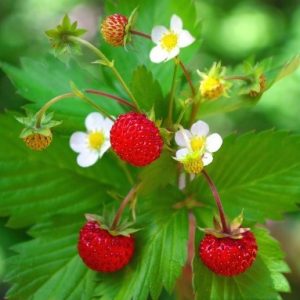
Wilds & Weeds
Just as strawberries are cultivated around the world, a “false” strawberry has become an international presence. The most immediately noticeable difference between domestic varieties and diminutive wild Fragaria species, and the mock indian strawberry “weeds” Duchesnea indica are the flowers. Domestic and true wild strawberries have white petals most often (some have rose-mauve hues). Those petals are also wider with only slight gaps, whereas mock strawberry petals are yellow, more oblong, and distinctly separated.
There’s also differences in berries. Mock strawberries are covered with protrusions the same texture and color as the rest of its skin. Like domestic strawberries, the tiny wild woodland and alpine varieties are dappled with seed-containing ovaries on the surface of the fruits.
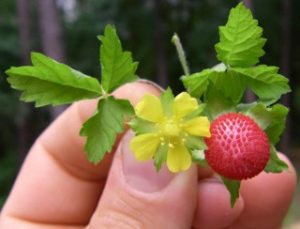
We don’t have to be haters, though. Mock strawberry fruit are dry and bland, but they are edible and contain valuable vitamins. Likewise, the leaves can be used for the same teas and topical poultices as both wild and domestic true strawberries and the other rosaceae brambles. Leaves make excellent additives for rabbits and chickens, too. Their early flowering also makes them important survival plants for pollinators in some areas.
If you have to have a weed, it might as well be a useful one. We have to control them, but they work well as edging around mown spaces, at the base of fences, buildings, and foundation plantings, as groundcover for well-established fruit trees and shrubs, and in chicken graze boxes.
Wild woodland and alpine types of Fragaria require less sun and have fewer pests and specific needs than domestics, but the mock indian strawberries are even more resilient, which makes them suitable for deeper shade and more soils. Unless we’re replacing them with something with higher yields or more uses, there’s no need to kill off the invaders this time around.
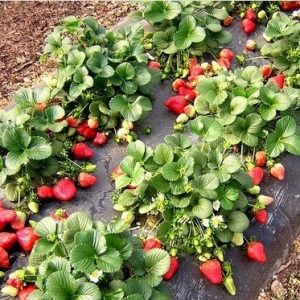
Strawberry Needs
In addition to the true wild varieties, there are three primary types of strawberries – day-neutral, everbearing, and Junebearers. All types fruit from buds they developed in a previous season. The separated budding-fruiting seasons contribute to strawberries’ increased productivity in the years after transplant. Trim runners and blossoms the first year so the plants’ energy goes into a stronger plant and root system. After that, root the runners into cups for transplanting or plan beds so staggered replacements can be rooted in-situ.
Strawberries will be happiest in a well-drained, loamy soil with slightly acidic to nearly neutral pH, typically 5.5-6.5 but some types will edge up into a 7.0. They need 6-10 hours of good light. If it’s particularly hot or dry, try to arrange shade directly overhead or blocking the hottest afternoon sun.
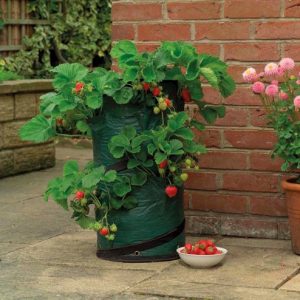
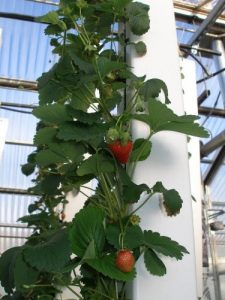
Strawberries are highly versatile and with their relatively shallow root systems and compact size, they can be grown in all aquaponics, hydroponics, and aeroponics systems: nutrient mist, NFT, flood-drain, floating raft/DWC (without pumps and aeration, even, although they need some water changes), and sponge or mesh media drip types like the clamshell ZipGrow or PVC DIY versions. They’re also adaptable to good ol’ dirt systems and herbicide-free straw-bale beds.
Strawberries in hanging planters, gutters along rails or laddered up walls, bottle towers, vertical pallets, and the gaps in CMU/cinder block need fertilized and watered more than in-ground and composting-tube tower and bin systems. Elevated containers do have advantages, though. Berries stay cleaner and it can be easier to keep them out of pests’ ranges.
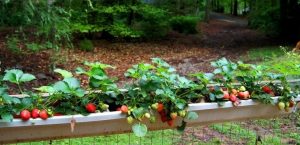
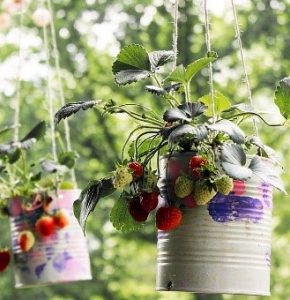
Vertical bottle and bucket/barrel tower, PVC, and hanging pocket systems also allow us to use slug barriers on a small footprint compared to a wider tub, bed or row. That lets us use fewer resources and spend less time protecting our berries, while also keeping the deterrents that would bother pollinators well away from plants and blossoms.
To overwinter, trim plants to 1-2” and cover them with 2-4” of mulch. If we’re using containers, we can lay them flat or stack them between beds, beside and under porches, or on decks and patios and give them an insulation barrier. If we’re in one of the environments where freezes are lighter and shorter, just tenting them in floating row covers may be sufficient. In warmer-yet climates and hothouses, we can keep everbearing and day-neutral varieties cycling year-round.
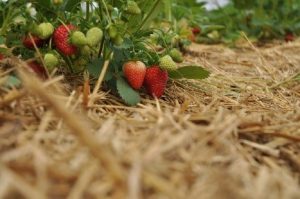
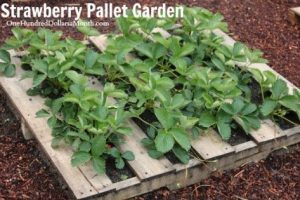
Mulching
Mulching always serves to retain moisture, prevent weeds, and protect soil from erosion and compaction. There’s also the benefit of preventing fruit “ground rot” and splash-up soil, which keeps harvests cleaner.
Strawberries are susceptible to some of the same diseases as many tree and shrub fruits, so source disease-resistant varieties and avoid planting near or using mulches made from diseased cousins. Straw, pine needles, and wood chips are all excellent options. Using wooden pallets as a planter or garden bed also limits exposure of and to the soil.
Leaves can be iffy. I do it, but only in places where I’m keeping ducks or have weedy islands and undisturbed areas for fireflies and other predatory and parasitic insects and small critters. See, using leaves encourages the one pest I really fight for my berries: slugs.
Slugs will also take advantage of boards, newsprint and cardboard on the surface. They work for me as an exclusion barrier under other mulches or to collect for birds, but on their own and left in place, it’s too much breeding and safety grounds for slugs and with not enough habitat and access for their predators.
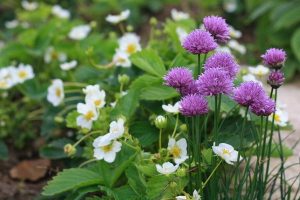
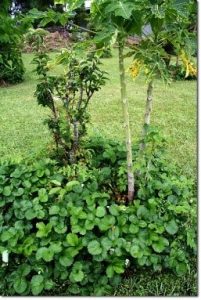
Companions & Bad Buds
Strawberries sometimes get a rap as not getting along well with others. Sometimes there’s a root-zone and nutrient competition issue – like sticking greedy sunflowers or voracious chives somewhere and having everything around them stunted. The runners and thick mat that can form can cause problems for some plants, but for the most part strawberries are compatible with both our perennials and some annuals.
Exceptions are brassicas, peppers, and tomatoes, potatoes, eggplant/aubergine, and okra. For the latter, it’s a case of mutual Verticullium susceptibility. Peppers are just picky, period. Cabbage-family plants are the only ones actually impaired by strawberries.
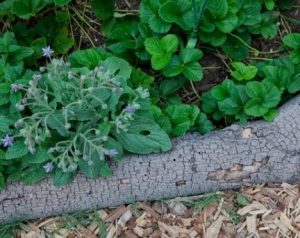
There are plenty of plants that can share with strawberries. Edible wild violets and violas can make for lovely arrangements, helping to camouflage our food production and enticing pollinators. Borage is one of the most common companions and is also edible.
Beans, onions, garlic, peas, and lettuces can all share with strawberries. The legumes will help replace nitrogen used by berries by the end of the season. We can interplant N-fixing flowers like lupin and crimson clover for the same benefits.
Biodiversity is its own wonder for health and pest resistance, but sharing beds with aromatic perennial herbs adds a layer of protection by masking them. Spinach is also touted as repelling strawberry pests. If root nematodes are a problem in the area, a 1:1 ratio of marigold biomass to our desired plants can help.
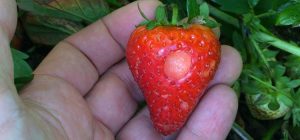
Slugs
Little is more frustrating than watching healthy, happy plants start blushing handfuls of berries only to find slugs have hollow them out the day before harvest. There are lots of ways to combat them, although some of the things that get passed around either just don’t work, or are highly conditional.
Coffee grounds, chipped pecan shells, and fine-ground and large-flake eggshells are commonly touted. They deter slugs a bit and sometimes work for other crops, but not ripe berries. This video https://www.youtube.com/watch?time_continue=72&v=N3MeFpXCXj0 might help dispel the notion that sharp edges are total deterrents.
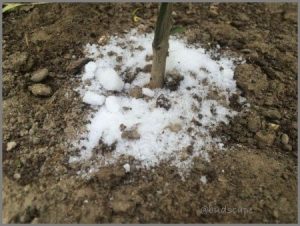
Coffee grounds, high-tanin walnut shells, and eggshells are useful, so there’s no harm, but they’re not a guarantee and don’t work long. Sevin dust and spray work for a while, but rain and even dews decrease the effectiveness after a couple of days, and Sevin and DE represent risks to earthworms, pollinators, and other beneficials.
I find Epsom salt pretty effective until rain or 3 days of heavy dew, too. Since I use it as an amendment, it can do some double duty.
Bait traps using either beer or a flour-yeast-sugar mix are pretty effective at lowering the slug loads. They can be used in pans set level with the ground or mulch surface, or be combined with bottle traps made similar to a tiny crawdad or fish basket trap.
We can also set up boards and inverted pots in garden areas, then flip them in the afternoon when slugs seek shelter and dispose of our berry-raiding nemesis.
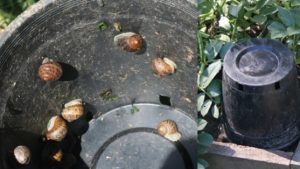
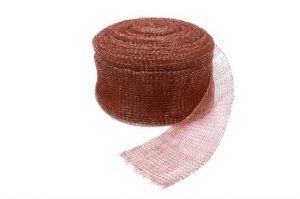
Copper rings and ribbon are also effective, although pretty expensive. However, it is a more permanent, all-season solution that should only have to be purchased and applied once.
Slug collars https://www.slughelp.com/slug-collar-to-protect-vulnerable-plants/ are another effective and lasting option, although if our plants hang over the edges, slugs can use the leaves as a bridge to the interior and suck our berries dry. We can use larger plastic bottles or wire hangers and plastic bags to DIY similar.
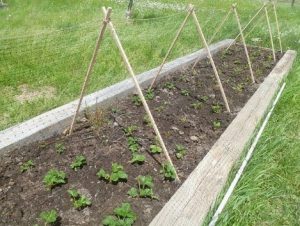
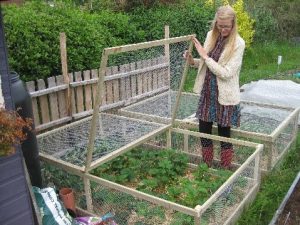
Pest Exclusions
For berry-raiding birds and squirrels, simple netting can work. I use rolls of permanent plastic or metal 12-24” hex chicken fencing or free salvaged cut hurricane/blizzard fencing around some beds to protect from dogs, rabbits and turtles, and lay white garden mesh across those. In other cases, I use hoops or stakes to suspend the mesh. The tighter mesh is my go-to just because it cross-purposes as insect exclusion and frost protection, and I already have it at hand.
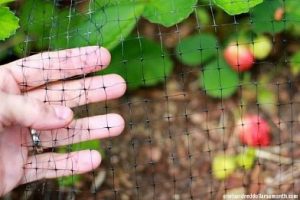
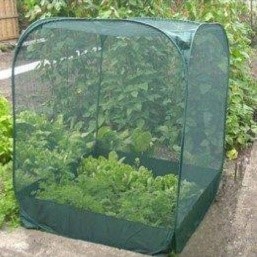
The thinner, looser mesh of deer or bird netting “disappears” at fairly short distances if appearance is a priority. We can also repurpose laundry bags and some types of baskets to create exclusions. Remember to leave access for weeding, fertilizing, pest control, and harvesting, whatever type of exclusion we use.
A set of solar “predator eyes” or garden terriers can help with more destructive and determined pests like raccoons. A pair of good garden ducks, leaving weed islands and some native shrubs to encourage predatory insects, amphibians, and reptiles, and encouraging bats can help, too.
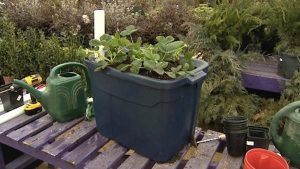
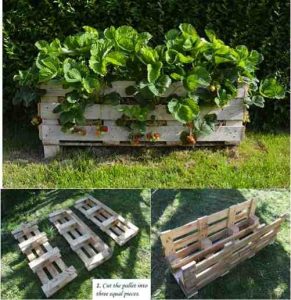
Spring & Summer Sweetness
Wild, mock or hybrid domestic, strawberries are compact and versatile enough to suit the needs of preppers at any stage, urban or rural, apartment to wide acreage. They offer us berries, but also leaves that can be used for teas and our livestock. The ease in propagation means we can start with just a handful and increase our stock with cuttings, divisions, seed, or their natural runners every season.
However, we’re not the only ones who love them. Some of the most common and persistent threats like slugs, rodents and deer affect the rest of our gardens and orchards, so finding deterrents that will be available should we face widespread disaster is a priority for preppers. We don’t want to find out during an emergency that something from a book or internet doesn’t work as well as we thought it would.
Follow The Prepper Journal on Facebook!
The post Survival Gardens: Strawberries & Slugs appeared first on The Prepper Journal.
from The Prepper Journal
Don't forget to visit the store and pick up some gear at The COR Outfitters. How prepared are you for emergencies?
#SurvivalFirestarter #SurvivalBugOutBackpack #PrepperSurvivalPack #SHTFGear #SHTFBag

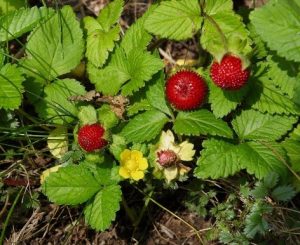
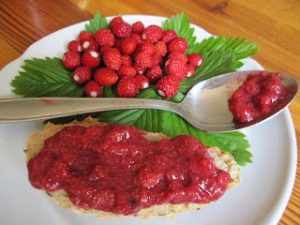
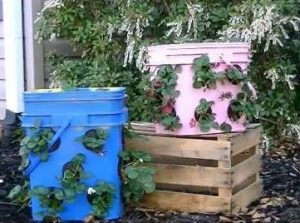
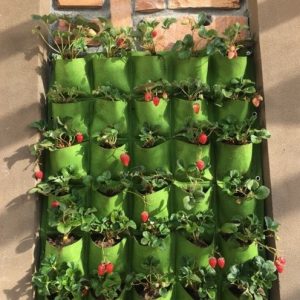

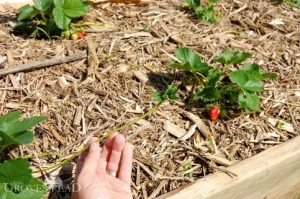
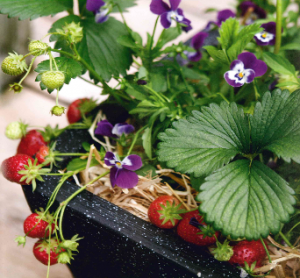
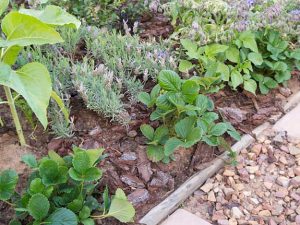
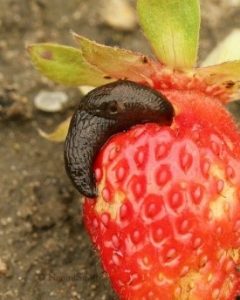

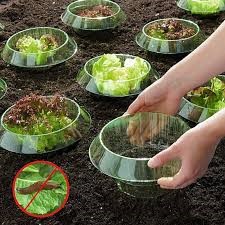
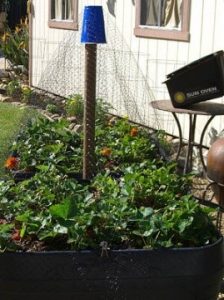

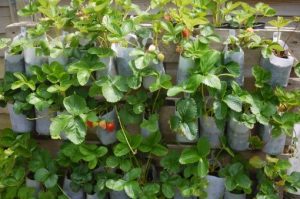
No comments:
Post a Comment